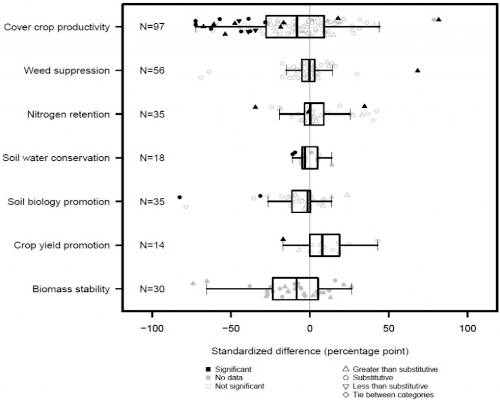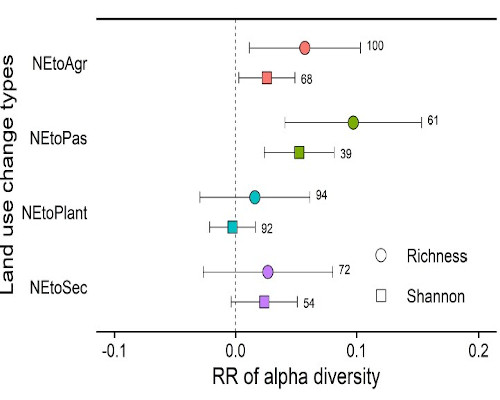We searched for all the published research on cover crop mixtures—you can read the details in the open access paper. We ended up with 27 studies from ten counties that gave us 243 full comparisons of the best mixture with the best monoculture for these measurements:
- Cover crop biomass
- Weed suppression
- Nitrogen retention
- Water conservation
- Soil biology promotion
- Following crop yield
- Biomass stability over time
Although the results differed for each measurement, the best mixture did not outperform the best monoculture consistently in any of them (Figure 2; from the paper). Overall, we found that mixtures were better in 2% of the comparisons, monocultures in 10%, and for the remaining 88% of comparisons, the best mixture performed comparably to the best monoculture. For those cases where there was a statistical difference between the best mixture and best monoculture, the monoculture produced more biomass in 17 comparisons, the mixture in only two.

Figure 2. Standardized difference between cover crop mixture and monoculture performance (N=285) separated by metric category. Positive values indicate where mixtures were superior to monocultures. Negative values indicate where monocultures were superior to mixtures. From Florence and McGuire, 2020 with permission from Wiley Online Library.
Contrary to expectations, the cumulative evidence thus far shows that cover crop mixtures do not give a clear advantage over monocultures. IF there are meaningful advantages of mixtures over monocultures, they are rare or difficult to attain. Why would this be?
Plant diversity and ecosystem function
Ecologists have long battled over what they call the biodiversity-ecological functioning question: whether higher biodiversity brings with it benefits in higher function, often measured in plants through biomass production. Much of the expectation of the benefits of mixtures is based on different species being able to access different resources which limits their competition with each other when living in the same space. This could also allow more complete use of the available resources (niche complementarity and niche partitioning). However, unlike with animals, plants all use the same basic resources, so to make this work ecologists have hypothesized that different plant species could access resources in different locations: “spatial resource partitioning across vertical resource gradients” (Barry et al. 2020). If this were true, tall and short plants, deep and shallow rooted plants, planted together would have an advantage over any single species.
A 2020 paper reviews past research regarding this idea (Barry et al. 2020). From 21 studies, they find that in grassland studies, where most of the biodiversity research has been done, the evidence in support of this idea is not strong; “we found little evidence for spatial resource partitioning along vertical resource gradients in more diverse grassland communities.” And they found this both for aboveground plant growth and belowground root growth. Contrary to expectations, diversity of form in plants does not consistently result in better efficiency or function.
Plant diversity benefits driven by soil fungal disease
Nevertheless, long-term grassland studies have shown that mixtures produce more biomass1 than monocultures. However, it often takes a year or up to 3-5 years for the advantages of mixtures to become apparent (Cardinale et al., 2007). A recent paper may help explain this. Van Ruijven et al. (2020) review the evidence for various mechanisms driving the plant diversity-productivity relationship and conclude that soil fungal disease is a likely cause.
Many fungal pathogens in the soil are plant-species specific; they affect one species and not many others. Disease from these fungi are much more serious when the susceptible species’ plants are densely planted than when they are spread out or when they are mixed with lots of other species not susceptible to the disease (called negative density dependence). With such a fungus in the soil, and there are many of them, a monoculture declines over time. It may outperform a mixture in the first year, as research has observed, but after 2, 3, 4 years, the mixture overtakes the monoculture because of the effects of the soilborne fungal disease.
Although this needs to be confirmed by further research, it would explain the lack of differences found between cover crop mixtures and monocultures. Unlike perennial grasslands, annual cover crops are not in the soil very long, just a couple months in many cases. This may not be enough time for the fungal disease to affect their growth sufficiently to give mixtures the advantage, especially when grown in diverse rotations. The same may hold for many intercrops with the exception of legumes+non-legumes where nitrogen effects from the legume dominate.
Plant diversity not linked to soil diversity
One last contrary finding. Another common belief is that a diverse mixture of plant species will drive greater diversity in the soil than a monoculture. This is often given as a reason to grow cover crop mixtures. Here again, we have a new analysis of the accumulated research investigating this mechanism. Zhou et al. (2020) analyzed 1235 experiments done around the world on the effects of what they call global change factors on soil microbial diversity. These change factors included land use change, such as occurs when a natural ecosystem is converted to agriculture, and nutrient fertilization. From this analysis they make several surprising conclusions.
First, most changes in the number of species (alpha diversity) can be explained by a change in pH. pH! It truly is the master variable in the soil. This is good news, as we can and often do manage soil pH.
Second, as they state it, “Conversion from highly diverse natural ecosystems to homogeneous agricultural monocultures has a positive effect on microbial alpha diversity.”
Read that again, a positive effect. The same goes for conversion to pasture.

Responses of microbial alpha diversity to different land use change types.
What is more surprisingly contrary is that this implies, and the authors state this, that changes in soil microbial diversity (number of species) are NOT linked to changes in plant diversity. I know, heresy, but thus sayeth the science.
This does not mean that the conversion to agriculture is all positive. The microbial biomass is reduced, probably due to the change from perennial to annual plants and the associated decrease in carbon flow to the soil3. Agriculture also changes the structure of the microbial community. What these structural changes mean in the crazily complex soil is a difficult question to answer, but they may all not be beneficial with respect to the soil or the environment. This does, however, remove another purported reason of growing cover crop mixtures.
Dealing with the contrary
So then, the current science tells us that cover crop mixtures are no better than monocultures, that the diversity in plant form (shoots and roots) does not lead to greater function in mixtures, that soilborne fungal pathogens may be the mechanism behind the advantage (in the long-term) of perennial plant mixtures, and that plant diversity is not linked to soil microbial diversity. All contrary to what we expected. Science is stubborn in resisting our ideals. Nevertheless, grow cover crops: grow mixtures, monocultures, in crops, before crops, after crops, summer, winter, spring and fall, grow cover crops.
Source : wsu.edu